2 Four Things Social Media Can Teach You about College Writing—and One Thing It Can’t
Ann N. Amicucci
Overview
Many students are frequent users of social media, and it’s important to recognize the rich rhetorical activity that happens on apps like Twitter, Instagram, Snapchat, and TikTok.[1] This chapter teaches students how to take rhetorical moves they make on social media and mimic these moves in academic writing, such as riffing off successful example texts, gearing content to specific audiences, choosing how to shape one’s ethos, and making stylistic choices that enhance the message of a piece of writing. By reading this essay, students will better understand the choices they make in composing text and images for social media and how those same choices can be applied to make their academic writing strong.
Have you ever had a writing assignment to work on but you find yourself scrolling through social media instead? You might think of social media as completely separate from the writing you do for college, but the truth is, the two aren’t that different. Sure, social media posts aren’t multiple pages long, double-spaced, or in MLA or APA Style. But the choices you make as a composer of text and images online are the same choices you need to make as a college writer. In this essay, I’ll show you how to take what you already know from writing on social media and use it to level up as a writer. I want to make college writing less of a mystery and help you learn techniques to stand out as a writer by building on what you already know.
Inter-What?
Before we dive into social media, there are two important concepts you need to understand: intertextuality and interdiscursivity. Both of these concepts refer to how writers borrow stuff from other writers:
- intertextuality happens when you explicitly borrow ideas or material from another text, which automatically links what you’re writing to something else. Examples of intertextuality include:
- quoting words or paraphrasing ideas from someone else’s writing.
- using photos or graphic images like charts or memes that someone else created.
- calling back or alluding to specific texts like songs, movies, books, or tv shows.
- interdiscursivity happens when you implicitly borrow or riff off the rhetorical choices of another text or writer. Examples of interdiscursivity include:
- formatting your paper and citations in a certain way because other texts do it.
- starting your writing with a quote or statistic because you’ve seen articles do this successfully.
- using features in your writing like funny side jokes or rhetorical questions that play off how other authors use these same features.
So why do intertextuality and interdiscursivity matter? Both these concepts are the ways your writing is networked with other texts and writers. Nothing you write exists in a vacuum. Instead, everything you write builds on ideas and texts that have come before and makes use of rhetorical choices or moves—strategies used to strengthen writing—other writers have had success with.
Here’s what I mean: Let’s say I’m writing a tweet about a restaurant I just tried (see figure 1). The intertextual parts of the tweet are the places where I specifically reference something else, like the chef, the tv show Guy’s Grocery Games, the name of the restaurant, and the city I live in. If I were to throw in a quote from a judge on the tv show or from the restaurant menu, that would also be intertextual content. Think of how each reference puts what I’m writing into a relationship with other texts in the world. Each makes my piece of writing one point in a big web of information that references these same things.

The interdiscursive parts of the tweet are the places where I use rhetorical moves I’m borrowing from other writers, like using hashtags, tagging the restaurant with its Twitter handle, and using the abbreviation “ftw” in place of “for the win.” These moves also put what I’m writing into a relationship with other texts and writers. Using hashtags shows I’m familiar with Twitter discourse, and using the abbreviation “ftw” might signal that I’m a gamer. Each interdiscursive move is a chance to get “in” with certain groups or to show that I’m not cool enough to be part of them. More on this in a minute.
You have lots of practice in writing with intertextual content for school. Every research paper you’ve written has likely used quotes, paraphrases, and even images or graphs from other sources. And you likely make intertextual references all the time by referring to popular culture or other texts to explain your ideas to your readers.
But you may not realize that you also have practice in using interdiscursive content on social media by imitating the rhetorical choices other texts make. In the following sections, I’ll explain how you can flex your interdiscursive writing muscles by bringing what you know from social media, regardless of what platforms you use, into your college writing projects.
Riff Off a Challenge
When I was writing this essay in 2020, TikTok was a popular app for sharing 60-second videos. When a new challenge emerges on a video platform like TikTok, you have to study its parts before you can copy it. As users replicate a challenge again and again, they riff off the challenge’s core moves, often mixing things up to make the challenge their own. A challenge video contains intertextual content: you’re using the name of the challenge that other people have used and often using the same soundtrack. But the process of imitating the challenge is interdiscursive work: you’re mimicking the format and components of a challenge but improvising changes to give your video a personal stamp.
Here’s an example. In the 2020 Stand Up Challenge popularized by Demi Bagby, two people work together to do a series of jumps to the song “Woah” by Krypto9095 featuring D3Mstreet. The challenge starts with one person lying on the ground and the other standing on the first person’s back, then with each move, the top person jumps up while the bottom person changes position until the top person stands on the bottom person’s shoulders, then jumps off and lands on the ground. As people recreated and riffed off this challenge, some users replicated the moves exactly while others did the series of jumps with pets or babies, some shared fail videos of when the moves didn’t work, and others created more complex versions of the challenge, like doing the moves in an indoor skydiving chamber (@twosdayswithtk).
When you start working on a college essay, pick an essay you admire to be your “challenge” essay that—like a TikTok challenge—you can replicate and make your own. You might pick a published essay you’ve read for class or an example student essay shared by your teacher. Your job isn’t to copy the essay, but to figure out its moves and meet the challenge by replicating those moves in your own way (see figure 2). As Craig A. Meyer explains, “In studying several authors or samples, we learn from each one’s strengths and weaknesses. Imitation is more than just copying down a selection of writing—it’s digging into the prose, pulling it apart, and understanding why it works the way that it does” (124). When you riff off a challenge essay, you’re still writing your own text—you’re simply using a successful formula to do so. Of course, you don’t want to simply copy a successful formula without considering the context for your writing. As you become more comfortable imitating successful rhetorical choices, you should reflect on how to adapt the rhetorical moves you riff off from other essays to best fit each writing project you take on.

Know Your Hashtag Audiences
Remember earlier when I used “ftw” in a tweet? Maybe you’d never heard that acronym before. Maybe it’s an abbreviation you like and use often. Maybe you think it’s ridiculous and rolled your eyes. Each language choice a writer makes marks that writer as an insider in some groups and an outsider in others—like if you’re a gamer who uses the acronym ftw, you might assume I’m a gamer, too.
Groups of people that share a common purpose and use language in specific ways to communicate with members of their group are called discourse communities. Dan Melzer describes them this way:
“Guitar players” or “people who like music” or even “guitarists in Sacramento, California” are not discourse communities. They don’t share the same goals, and they don’t all interact with each other to meet the same goals. . . . But a Meetup.com group like the Sacramento acoustic guitar jam focused on a specific topic with shared goals and a community of members who frequently interact can be considered a discourse community. (102-03)
Melzer explains that in his acoustic guitar jam Meetup, members used specialized words and explanations like “root note of scale” and “putting a capo on different frets” so they could achieve their group goals. He writes, “We didn’t use this language to show off or to try to discourage outsiders from joining our group. We needed these specialized terms—this musician’s lexis—to make sure we were all playing together effectively” (105). All those specialized ways of using language are interdiscursive action: rhetorical moves to show you’re a member of a certain group because you use language in the same way as other members.
Discourse communities work the same way on social media. We use language in specific ways to connect with people who share our interests and to achieve goals in interest-related groups. On Instagram and other platforms, using hashtags to link your posts to related posts is an interdiscursive move. You make a rhetorical move every time you choose to use hashtags in general, decide when and how to use them, and decide which to use. Further, you make interdiscursive rhetorical choices in composing a photo and a photo caption to participate as a member of certain hashtag communities.
For example, in a post about her latest mural, artist Jeresneyka Rose, whose handle is @ArtByRizzo, selects a series of photos showing herself painting the mural and the completed project (see figure 3). She captions the photo, “Growing & Glowing 🌼 First Mural of 2020 💙. Timelapse uploaded to IGTV!” and includes nineteen hashtags at the end of the caption. Her hashtags include general tags like #IndoorMural, tags specific to who she is as an artist like #BlackWomanArt, and tags specific to her community like #ColoradoSpringsArtist.
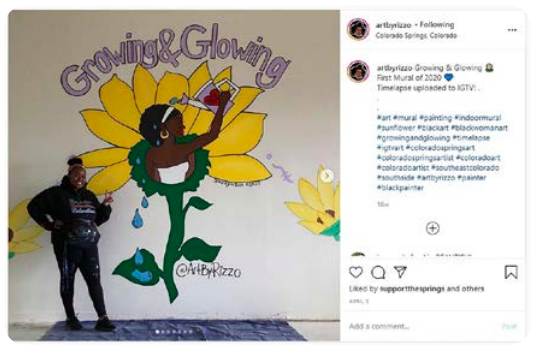
(Jeresneyka Rose).
Rose’s post as a whole has a purpose: to celebrate and circulate her art. What’s more, each part of the post involves specific interdiscursive rhetorical choices that have multiple, finer-grained purposes of linking the post with discourse communities. Think about how each hashtag represents a different community and the ways those communities overlap. For example, #BlackArt represents a huge worldwide community of Black artists, #ColoradoSpringsArtist represents a much smaller, local community, and some artists belong to both (see figure 4). When Rose uses multiple hashtags, she is composing content that works in each tag separately as well as in the space where tags intersect.
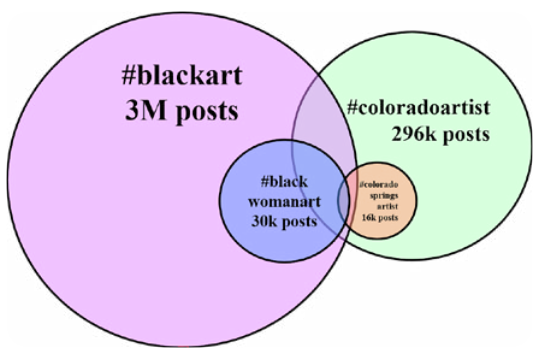
The content of Rose’s photo and what she writes in her caption not only need to make sense for the groups she’s connecting to; this content also needs to get those groups’ attention and work within those groups’ shared goals. The positive message of Rose’s mural—which shows a Black woman nourishing herself from a watering can of self love—combined with Rose’s smile, the peace sign she makes with her fingers, and the flower and heart emoji in her caption all show her desire to work toward a goal of empowerment of and positivity among Black women and artists.
So what does this mean for you as a college writer? When you write an essay, think about what hashtags you’d use to label it if it were a post. What topics does your essay connect with, and what groups of people are interested in those topics? Decide how you’ll shape the ideas in your essay and your language choices to fit the groups of people you’re trying to reach. If it seems like your assignment is only asking you to write to your teacher, consider the multiple audience groups your teacher belongs to, such as education professionals, residents of your area, or members of a group that engage in a certain hobby or interest. Even when you’re directing your writing to one person, that one person belongs to multiple audience groups.
You can also invent a more specific audience for yourself. For example, if you’re given an assignment to analyze a political cartoon, think about the multiple groups you could gear this analysis toward. If you’re writing to middle school students to teach them how to read political cartoons critically, you’ll use different ideas and language than if you’re writing to your campus newspaper to propose that cartoons should become a regular feature. Present every idea and make every language choice in your essay with your specific hashtag audience or audiences in mind.
Pick Your Filters
If you’ve read up to this point, you know that two ways you can take what you know from social media into your college writing are to 1) pick a challenge essay to riff off and 2) identify hashtag audiences to connect with. Here’s a third way: Decide what version of yourself you want to be in your essay, and choose filters to make yourself appear a certain way.
Imagine you’re composing a selfie on Snapchat or another app with a range of filters to choose from. You have so many choices to make just in the photo alone: whether to smile, whether to show only yourself or include your background, how to angle your camera, and so on. Once you decide how to pose, you might scroll through the lens options to filter your face or give yourself animal ears, then you’ll choose whether to add stickers, a caption, or a frame for your photo.
Let’s say I’ve just gotten home from a long hike on a hot day and I create a snap. I could choose a flattering lens, inspirational stickers, and a congratulatory caption to portray myself as a determined go-getter who has just achieved a big goal (see figure 5), or I could use a funny lens and a more honest caption and stickers to reveal how exhausted I am and portray myself as light-hearted and self-deprecating (see figure 6). Each choice I make shapes my ethos: the way I’m constructing my own character through my snap.
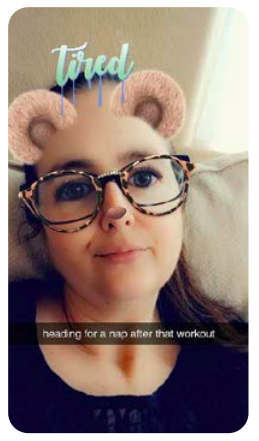
Image credits: Ann N. Amicucci.

The same is true when you’re writing a college essay. You have to decide how to present yourself and whether you want to present a simple (no filters) or gussied-up (sparkles and animal ears galore) version of your character in a particular piece of writing. The genre you’re writing in and how much freedom you have within that genre will guide what choices you have in constructing your ethos. If you’re able to include multimedia in your essay, consider how you can send different messages about yourself in your writing by choosing to include a soundtrack, photos that you take of your subject, or a diagram or graph that you draw by hand or create in PowerPoint. If multimedia composing isn’t an option, shape your ethos through your language: Choose words, phrases, and sentence types that enable you to be formal or funny or anywhere in between.
Let’s say you’re writing an essay that analyzes the rhetorical strengths of Sojourner Truth’s speech “Ain’t I a Woman?” Truth was a slave who escaped and became a travelling preacher and activist for antislavery and women’s rights (“Sojourner”). You already know what argument you want to make in your essay—that Truth uses appeals to religious and family values to soften men in her audience to the idea of women’s rights. But who do you want to be in making this argument? Perhaps you could use a filter I’ll call “The Activist.” To portray yourself as a strident advocate for women’s rights (regardless of whether you identify as a woman), you could discuss how Truth’s work set the stage for today’s advocacy for women by sharing an anecdote of your experiences with the struggle for women’s rights and including a photo of you or someone you know participating in a women’s rights rally. Or you could go in a completely different direction and use a filter I’ll call “The Wanderer.” To portray yourself as a person journeying through life in search of meaning, you could use an epigraph from environmental writer Rebecca Solnit and subheadings like “Setting a Path,” “A Fork in the Road,” and “The End of the Journey” to highlight the role of Truth’s travel in strengthening her message.
Your filter will also shape what evidence from the speech you include in your essay. Arguing from an activist position may lead you to quote passages that draw readers’ attention to the injustices Truth faced. Arguing from a position of your own journey, however, may lead you to put those same passages in your own words or select different sections of the text to discuss altogether. Adding a photo, using certain subheadings, or selecting different quotes are only a few of the choices you’ll make based on how you’re presenting your own ethos. Think of the countless choices you make in taking and posting a photo; you make a similar list of choices in deciding how to present yourself in an essay.
You can use either of these filters for your ethos, and the central argument in your essay stays the same. What changes is the character of the writer making that argument. Keep in mind that there’s never a piece of writing where you aren’t present. Even if you aren’t using the first person pronoun “I,” you’re always a part of your own writing—so decide what filters you want to use on yourself in your essay.
Say More Through Symbols
On social media, we use emoji and stickers to add meaning to the words and images we share. If I post about traffic making me late to a family event and include a sad face emoji, you’d know I’m disappointed (see figure 7). But if I include a winking face and a celebration emoji, you’d understand that I’m happy to be late to the picnic—and you might even wonder if I’m making up the traffic as an excuse (see figure 7). Emoji and other symbols tell readers how the content of your writing on social media should be read.
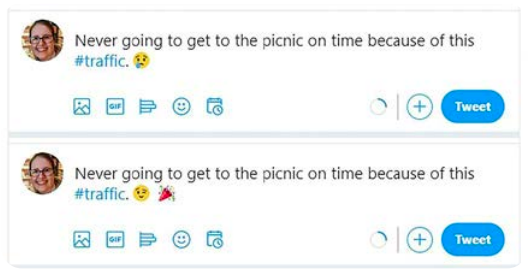
Look at the tweet in Figure 8 from my campus, which shows an image of students in the 1960s waiting in line to register for classes. The surprised face emoji that appears in the tweet tells us to be shocked by what we see: by both the length of the line and the fact that people had to show up to a particular building to register for classes in person.
Now, notice the other composing choices that went into this post. The picture is a black and white photo from the 1960s, and no words or stickers have been added to it. The middle third of the photo shows students in line, but the photo hasn’t been cropped to focus only on the line of students. Instead, the parts of the photo that show us features of campus at the time—trees, grass, a building—have been left in to show that my university’s alumni association is interested not only in saying something about how registration worked at the time but in giving us a view of campus in the 1960s as well. Take a moment to imagine how you could shift the message of this post if you used different emoji, chose punctuation other than a period at the end of the tweet, or cropped the photo.
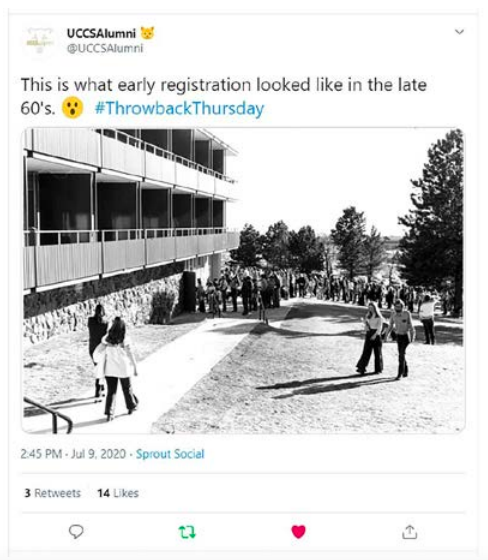
So how can you apply similar choices to your college writing? Let’s say you need to write an essay about something you’ve observed at your college. It’s unlikely that you’ll use emoji in your essay, but you will use punctuation to signal to your readers how to interpret your message. Kevin Cassell explains that when you notice punctuation while you read, you’ll discover how punctuation marks work rhetorically. Referring to a paragraph in his Writing Spaces essay, Cassell writes:
Some of [the punctuation marks] I had to use to meet standard usage expectations: periods to end sentences, apostrophes to make contractions or show possession, question marks to indicate questions, and commas to set apart clauses. Other punctuation marks I used—like the em dash, exclamation points, italics, ellipses, quotation marks to create emphasis, and even the parentheses—were optional, rhetorical choices I made to emphasize certain things and give my writing a colloquial style. (9)
In making rhetorical choices among all the punctuation marks Cassell names, you’ll communicate meaning to your readers.
Let’s say you’re a student in your thirties and you decide to use your essay to make recommendations for how your college’s website could better fit the needs of older students. If you want readers to interpret your essay as that of an indignant student who is demanding change immediately, you might use question marks to frame your statements as rhetorical questions or use italics to call attention to words that highlight the urgency of your request. However, if you want to frame your essay as a thoughtful description of your experiences—not necessarily an accusation or an indication that anyone is in the wrong—you might use em dashes, such as those in this sentence, to include thoughtful asides, or ellipses to show pauses in your own thought process as you navigated the website.
You can write multiple versions of an essay that make the same argument that the website should be revised to better suit the needs of older college students. Yet the choices you make in punctuation add layers of meaning to your words and help your readers understand how to interpret your message, just as emoji clue readers into the real message in tweets.
Don’t Cut Your Ideas Short
So far in this essay, I’ve taught you four techniques for bringing your social media composing skills into college writing. Before I go, I want to mention one thing you shouldn’t take from social media into your academic essays. On social media, it’s common for writers to share an idea without saying much about the idea itself. I can post a pic of a doughnut with the caption “I love doughnuts” without needing to say why I love them, and no one will think it’s strange. But in college writing, the opposite is true: You need to include the why.
No matter what subject your essay is on, you’ll be making claims throughout it. A claim might be an opinion (“I think our campus is great”), an argument (“Rose empowers Black female artists through her Instagram posts”), or even a proposal (“No one should take the TikTok Stand Up Challenge”). Each time you make a claim, you have to include reasons to support your claim and evidence to support your reasons. An easy way to make sure you do this is to draft your essay, then go back and reread what you’ve written. After every single sentence, ask yourself the questions “How?” and “Why?” If the sentence that follows explains the how or why, you’re good to go. But if the how and why aren’t present, you need to add more content to explain and justify your claims.
The next time you’re scrolling through social media instead of working on an essay, pay attention to the choices made in each post. Then dive into your academic writing: Study the essays you’re reading for class and notice their rhetorical moves so you can riff off them. Think about your hashtag audiences, choose filters to shape your ethos in your writing, and use punctuation to shape your message. Just don’t forget to include the why! Playing off of social media’s strongest features while also explaining and justifying your ideas fully will give you the best chance of being a strong writer in college.
Works Cited
@ArtByRizzo (Jeresneyka Rose). “Growing & Glowing.” Instagram, 2 Apr. 2020, https://www.instagram.com/p/B-fY4zAgBZz/.
Cassell, Kevin. “Punctuation’s Rhetorical Effects.” Writing Spaces: Readings on Writing, vol. 3, edited by Dana Driscoll, Mary Stewart, and Matthew Vetter, Parlor Press, 2020, pp. 3-17.
@demibagby (Demi Bagby). “Stand up challenge!!!” TikTok, 21 Jan. 2020, https://www.tiktok.com/@demibagby/video/6784536387992440070?lang=en.
Krypto9095. “Krypto9095 Ft. D3Mstreet Woah (Official Song to Woah Dance).” YouTube, 3 Nov. 2018, https://www.youtube.com/watch?v=afRki2_aNKg.
Melzer, Dan. “Understanding Discourse Communities.” Writing Spaces: Readings on Writing, vol. 3, edited by Dana Driscoll, Mary Stewart, and Matthew Vetter, Parlor Press, 2020, pp. 100-15.
Meyer, Craig A. “The Evolution of Imitation: Building Your Style.” Writing Spaces: Readings on Writing, vol. 3, edited by Dana Driscoll, Mary Stewart, and Matthew Vetter, Parlor Press, 2020, pp. 116-27.
“Sojourner Truth: Ain’t I A Woman?” National Park Service, 17 Nov. 2017, https://www.nps.gov/articles/sojourner-truth.htm
@twosdayswithtk. “so @hamish_brissett & @hal_pal1021 did this challenge the best!” TikTok, 28 Jan. 2020, https://www.tiktok.com/@twosdayswithtk/video/6786898195692801286.
@UCCSAlumni. “This is what early registration looked like in the late 60’s.” Twitter, 9 July 2020, 2:45 p.m., https://twitter.com/UCCSAlumni/status/1281328537132249089.
Teacher Resources for “Four Things Social Media Can Teach You About College Writing—and One Thing It Can’t”
Overview and Teaching Strategies
This essay invites students to consider how the rhetorical moves they make on social media can be transferred to academic writing. The essay aims to demystify academic writing by helping students see that similar rhetorical processes happen across all writing genres and that academic writing tasks aren’t divorced from everyday writing practices. The essay can be taught as part of a unit on literacy narratives or other investigations of students’ existing literacy practices, alongside lessons on style and rhetorical experimentation, or in conjunction with other course content that focuses on social media or multimodal composing.
I find that when students are asked to reflect critically on their social media writing practices, they are perceptive of a range of rhetorical choices they make in adapting digital content to fit audience expectations or to provoke audience reactions. Yet students are less practiced in carrying these rhetorical choices into academic writing or in seeing connections between everyday digital writing and more formal academic prose. I recommend beginning an assignment sequence or class discussion by asking students to reflect on and analyze their own digital composing choices prior to assigning this essay, then following students’ reading of the essay with discussion or writing about specific rhetorical moves students can bring from their social media practices into a college assignment.
One area where teachers may encounter resistance is from students who avoid or opt out of social media. When I encounter students who aren’t inclined toward social media participation, I ask them to reflect more broadly on their everyday writing practices such as texting, making to do lists, writing emails, writing notes to family members, and on everyday rhetorical choices such as selecting clothing and accessories. While some students may not participate in the literacy practices the essay describes in networked spaces, all make rhetorical choices in self-sponsored writing and in composing their own persona each day that they can apply to college writing projects.
Discussion Questions
- Choose a social media platform you participate in, and make a list of all the groups of people who read your writing on this platform. In addition to the forms of social media listed in the article, consider whether you participate in LinkedIn, Pinterest, Yelp, dating sites, or gaming sites. Draw a Venn diagram to show how your audience groups are related and whether and how they overlap.
- The essay suggests choosing a “challenge essay” to imitate in your own writing. What nonfiction text have you read that you’d like to imitate as a writer? Return to this text, skim it, and make a list of the rhetorical moves the author uses that you’d like to imitate. Which rhetorical moves will be the most difficult to accomplish, and why?
- Find a tweet that uses at least one emoji or at least one punctuation mark. Rewrite the tweet five times, using different symbols or punctuation each time. Explain how your choices change the meaning of the tweet in each version.
For more discussion of how changing punctuation changes a sentence’s meaning, read Kevin Cassell’s Writing Spaces essay “Punctuation’s Rhetorical Effects.” - The essay discusses the difference between intertextual references and interdiscursive rhetorical practices in writing. Consider the outfit you’re wearing today. Which elements of your outfit are intertextual? That is, which parts of your clothing or accessories specifically reference other existing texts? Which elements of your outfit are interdiscursive? In other words, what rhetorical choices did you make in assembling your outfit that mimic or riff off others’ rhetorical choices?
- Each Snapchat lens that filters your image has a name, like Starry Sunlight, which casts an amber color on a photo and makes small gold sparkles appear on the screen. Think of how you presented yourself in the last academic essay you wrote. What name would you give to the “filter” you used for your own presentation in that piece of writing, and how would you describe that filter? What name would you give to the filter you’d like to use to present yourself in your current writing course, and how would you describe it?
- This work is licensed under the Creative Commons Attribution-NonCommercial-NoDerivatives 4.0 International License (CC BY-NC-ND 4.0) and is subject to the Writing Spaces Terms of Use. To view a copy of this license, visit http://creativecommons.org/licenses/by-nc-nd/4.0/, email info@creativecommons.org, or send a letter to Creative Commons, PO Box 1866, Mountain View, CA 94042, USA. To view the Writing Spaces Terms of Use, visit http://writingspaces.org/terms-of-use. ↵
